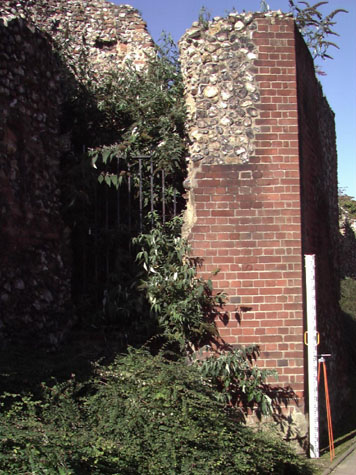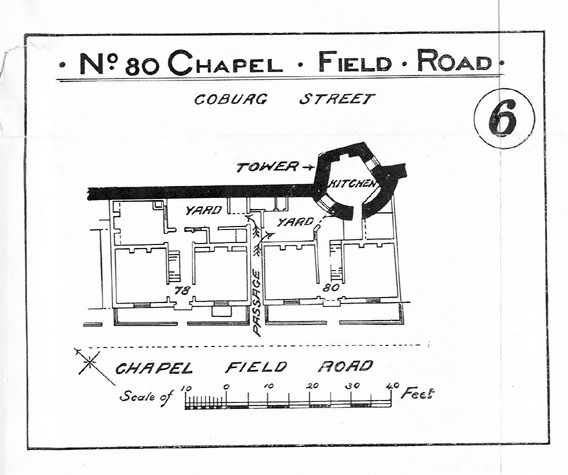|

[1] The inner side of the tower from the south.

[2] Plan of the surviving wall published in the report of 1910. This
shows the houses built against the walls in the 19th century.

[3] Plan of the tower published in the report of 1910.
|
Introduction
The longest single section of the city wall was between
the Gate at St Giles and St Stephen's Gate. The wall,
shown clearly on Cunningham's map of 1558, was some 675
metres long with 229 battlements and six intermediate towers.
Although this is the highest part of the city, the ground
is relatively level rising just 4 metres between the gates.
A substantial section of the wall survives at Coburg Street
and in many ways this is the most prominent and most seen
section of the wall, at one of the main entrance points to
the city and close to one of the main shopping streets.
The surviving section of the wall at Coburg Street is
just over 240 metres long and, though there are several wide
breaks or breaches, it runs from the south-west corner of
Chapelfield Park to St Stephens. The fourth tower of the
original six between the gates was at the north end of the
Coburg Street section, at the south corner of Chapelfield
Park, at the end of the road now called Chapel Field East.
It was probably demolished in the late 18th century. The two
intermediate towers that survive form the main features of the
external elevation of the Coburg Street section. The fifth
tower is polygonal, standing to a height of 6.5 metres,
[1]and the sixth or south tower
with a horse-shoe shaped plan survives in a more derelict
state towards the south end of this section.
[see report 24]
The wall between the surviving towers stands at over 5
metres high in some parts and the line of the internal walk
along the top of the wall can be seen clearly in several
places showing that in those parts just the narrow outer
parapet has been lost. The parapet would have added almost
2 metres to the overall height of the wall. The crenellations
of the parapet - the merlons, embrasures and intermediate
loops - would have been formed in brick as on the surviving
fragments at Ber Street and Carrow Hill.
It is possible that the north part of the Coburg Street
section, on either side of the polygonal tower, has never
had an arcade on the inner side and would have linked through
with the plain section of wall along the west side of
Chapelfield Gardens. This and surviving documentary evidence
implies that this section of the wall may be one of the
earliest parts of the defences where a bank and palisade were
first replaced by a more substantial wall in flint and mortar.
Map evidence suggests that there were no buildings close
to this section of the city walls until the 19th century,
apart from a block of houses on the site of the present Co-op
store which faced on to St Stephens and on to Back St Stephen's,
now Coburg Street. Generally, around the medieval city there
was a road or lane immediately against the city side of the
wall which is marked on early maps as 'the way inside the
wall'. All the obvious repairs and patches along the
wall on both sides at Coburg Street appear to be the consequence
of building houses, yards and outbuildings hard against both
sides of the wall in the 19th century. All these houses are
shown on a survey plan published in 1910.
[2] The extent of alterations and encroachment into
the fabric of the wall can be seen at the site of number 80
Chapel Field Road which had a narrow yard to the rear with the
tower on the far side of the yard. A doorway was actually cut
through the north-west side of the polygonal tower and the
ground floor of the tower was converted into a kitchen and
the upper chamber was used as a bedroom. [3]
The last of these houses was demolished in the 1970s when
a dual carriageway, part of the inner city ring road, was
constructed on the west side of the wall and a narrow foot
path was built on the east side bounded by mauve/grey brick
walls.
Small-scale archaeological excavations across the line
of the wall and in an area behind the wall were undertaken
in 1969, 1972, 1973, 1974 and 1975. The general conclusion
in the reports was that the medieval wall here had been built
with little or no foundations and was in some places built
on a level of loose sand. There is also the suggestion in
these reports that the wall was built on the line of an earlier
bank which itself had an outer defensive ditch. The outer
ditch, on the west side of the 13th-century wall, has been
loosely filled with building debris.
In the construction of a new wider road on the outer side
of the wall in 1974/5, a regular and gradual slope was achieved
by general levelling along the line of the wall. This exposed
much of the lower levels of the wall particularly in the centre
of this section. At the south end of the wall on the city side,
the present pavement is as much as 800 mm below the medieval
level. The shallow foundations of the original construction
and this recent undermining have caused some sections of the
wall to settle into the ditch and lean outwards.
A major redevelopment of the factory site on the east side
of the wall is at the planning stage and it has been proposed
that the foot path on the inner side of the wall should be
widened and the setting of the wall enhanced as part of that
scheme.
|
